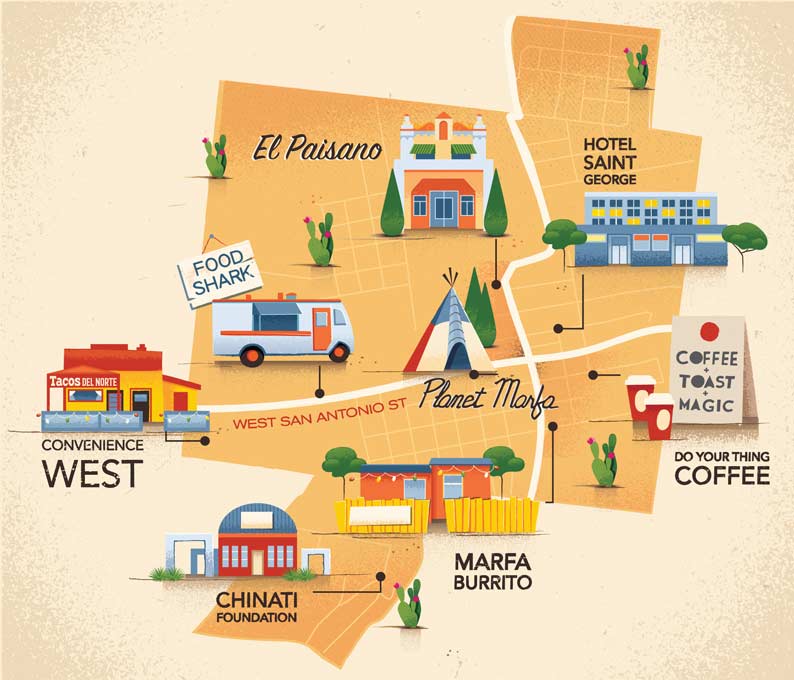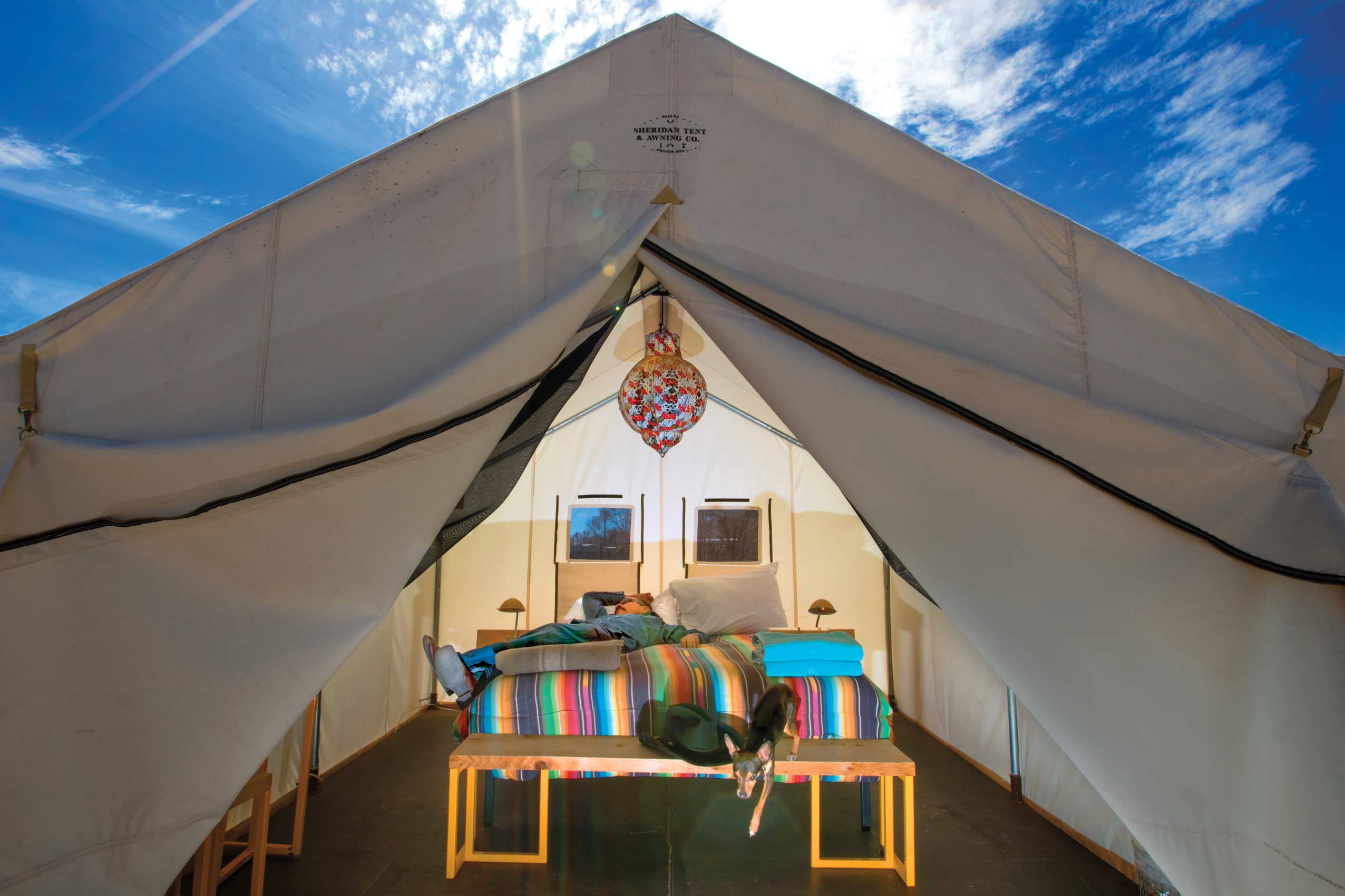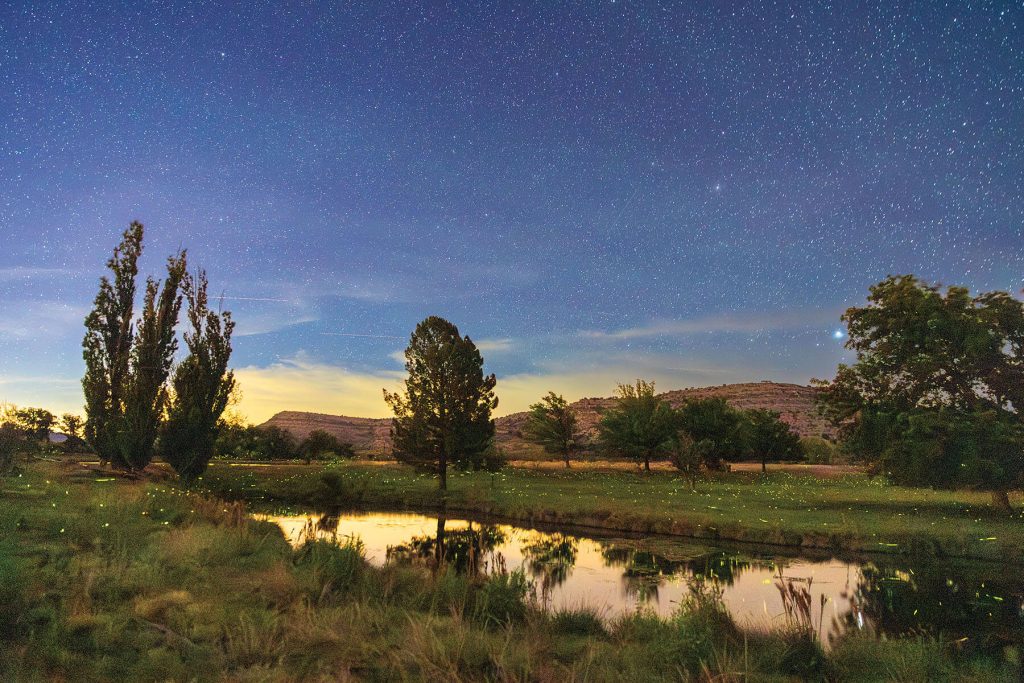
Illustration by Chiara Vercesi
The land and the light and a sense of space unlike anywhere else.
Marfa
For visitor information, call Visit Marfa at 432-729-4772
visitmarfa.com
That’s what attracted renowned Manhattan artist Donald Judd to Marfa in the ’70s. His large-scale installations, which meld sculpture and nature on an old Army base renamed The Chinati Foundation, made this far West Texas town a destination for the international art crowd. But in recent years, “The Capital of Quirkiness” (as CBS’ 60 Minutes dubbed it in 2013) has broadened its appeal to “bucket list” millennials and tourists who might think Donald Judd was Wynonna’s pop. A fascination for Hollywood in recent years, Marfa also enjoys frequent coverage in The New York Times—which ran at least eight stories with a Marfa dateline in the past two years (including four in the paper’s fashion supplement). All this attention has helped convert this tiny town with its own NPR station into the San Francisco of the Texas desert.

Going to Marfa without a visit to The Chinati Foundation is like a trip to Niagara without seeing the falls.
The nouveau influx might expect some sort of hipster theme park (Schlackerbahn?) when they approach on US 90. But being the Marfa people expect isn’t very Marfa-esque—this town challenges tourists like abstract art. “Nobody’s gonna make it easy for you,” says Ginger Griffice, proprietor of the Marfa Brand soap company. “There are no signs that tell you what’s cool.” After a first spin around the dusty streets, the song in some heads might be Peggy Lee’s “Is That All There Is?” Where are Beyoncé and Solange? Where’s all the hip stuff we’ve heard about?
Getting There
El Paso
3 hoursAustin
7 hoursDallas
8 hoursHouston
9 hours
Oh, it’s there, but Marfa is a town where almost everything interesting is bubbling under the surface. Example: An old church is a provocative art gallery called the Wrong Store, but you can barely see it from the road for the trees in front. “Tough to get to; tougher to explain” is a slogan printed on brochures distributed by the Marfa Visitor Center, which is housed in the old USO building on South Highland Avenue. That’s a good place for Marfa virgins to start, as is the dome of the pinkish Presidio County Courthouse, built in 1886 when Marfa was just a water stop for steam locomotives. The view from the courthouse cupola provides a panoramic bird’s-eye of the town. From on high, the serene, heavenly lit landscape is the star.
Marfa’s not a day trip; it’s a pilgrimage. It takes such an effort to get here—a nine-hour drive from Houston, eight from Dallas, seven from Austin, six from San Antonio, and three from El Paso—that it’s natural to hope everything’s easier once you arrive. But since the town is built on self-discovery, you’re on your own. Signage is more often a reflection of the creativity of the business than a guide for the lost or curious.
One such place is The Lumberyard, a collection of studios for painters, artisans, woodworkers, and fashion designer Ashley Rowe—from a car going 20 mph, it looks like lumber might still be stored there. The happening compound is also home to the Do Your Thing coffeehouse (famous for its porridge and “Jerusalem Toast”—housemade country sourdough with avocado, tahini, za’atar, toasted sesame seeds, and a fried egg), plus the Adobe Room, an unusual Airbnb rental, which doubles as a theater space during the annual Marfa Film Festival in July.

The Lumberyard, a collection of studios for painters, artisans, and woodworkers.
Visiting Marfa on a weekday can feel like going to Wrigley Field when the Cubs are in St. Louis. Someone should write a sad country song: “Since my baby up and left/Every day’s like Monday in Marfa.” With the Chinati Foundation closed Mondays and Tuesdays, there’s just not enough local business to stay open, says Adam Bork, whose Mediterranean-styled Food Shark (est. 2006) presaged the nation’s food truck craze by a few years.
The acclaimed Marfa Burrito, famous for handmade tortillas the size of bath towels, is one of the few eateries open on Mondays—at least, that’s what the sign says. (On a recent Monday, Marfa Burrito’s front door opened to a dark and empty restaurant; a woman doing yard work eventually confirmed that the restaurant was closed because the workers hadn’t shown up that day. Welcome to Marfa.)
Since the town is built on self-discovery, you’re on your own. Signage is more often a reflection of the creativity of the business than a guide for the lost or curious.
The seven-days-a-week Marfa is anchored by the posh Hotel Saint George (built on the site of the 1886 hotel of the same name), which opened to rave reviews in 2016 with 55 rooms and suites. Besides four-star restaurant LaVenture, the lobby area has an austere bar on one side that serves a wagyu beef cheeseburger worth its $12 price tag, and then on the other side of the front desk is the fabulous Marfa Book Company, specializing in art, Texana, and fiction. Every hotel should have such a well-curated independent bookstore.
But the best thing the Saint George has brought to Marfa is across the street at Bar Nadar Pool + Grill, open to the public from 4-11 p.m. (21 and over, except Tuesdays, which is Family Night). With shaded cabanas, luxurious lounge chairs, and all the beautiful people, the hotel’s pool evokes Hollywood in the ’50s, except with tattoos. If you’re lucky, there will be a show while you’re in town at the adjoining Saint George Hall, a 600-
capacity venue that hosted the likes of David Byrne, Los Lonely Boys, and Ruben Ramos in its first few months. These concerts, and events at the 175-capacity Crowley Theater performing arts space, are the only times there are parking problems in Marfa.
The Saint George complex has the luster of the new kid on the block, but the reborn Hotel Paisano downtown has lost none of its stature as the classic Texas rancher hotel. This is where the cast of Giant—including Elizabeth Taylor, Rock Hudson, and James Dean—stayed during filming in 1955. The hotel’s memorabilia room sells re-creations of the original key tags with the actors’ names and room numbers.

The Well day spa offers yoga and meditation classes.
From the Paisano, a short stroll down Highland Avenue (Marfa’s main street) will take you past The Well day spa, which offers yoga and meditation classes, haircuts, massages, and facials. Walk back toward the courthouse, and you’ll want to pop into Ranch Candy Marfa/Spare Parts, an offbeat shop that specializes in vintage Western wear, jewelry, and hard candy.
Marfa Brand, which sounds redundant, is the creation of the aforementioned Griffice, a former New York City location scout. A Dallas native, she bought a vacation home in Marfa in 2004. Since this town between the Davis Mountains and Big Bend is a magnet for West-set films like No Country for Old Men and There Will Be Blood, Griffice was able to continue scouting for films. But such work is irregular, so she started making soap—experimenting with ingredients such as rosemary, Earl Grey tea, goats’ milk, patchouli, and honey. “I’m not an artist, but I wanted to make something,” Griffice says. “It’s the small-town thing to do.” Ginger’s shop in The Lumberyard opens to the public Wednesday through Sunday, but you can also buy her products across the street at The Get Go, a specialty grocery store, and at El Cosmico, a 21-acre escape from the “built world,” where hotelier Liz Lambert introduced yurts, teepees, and vintage travel trailers to Marfa’s accommodations in 2009.

El Cosmico, a 21-acre escape from the “built world,” introduced yurts, teepees, and vintage travel trailers to Marfa’s accommodations in 2009.
Another key figure in Marfa becoming more than a destination for fans of Donald Judd and the spooky Marfa Lights (ghostly lights that dance between the prairie and the mountains at night, which some killjoys explain as reflections of headlights from a nearby highway) is former Austinite Virginia Lebermann, who co-founded the nonprofit art gallery Ballroom Marfa, and co-owns the fabulous Capri restaurant with her chef-husband, Rocky Barnette, and the carefully renovated Thunderbird Hotel with her mother, Louise O’Connor. Barnette’s elevated regional cuisine (tempura-fried yucca blossoms are popular) earned its own feature in The New York Times.
“I’m not an artist, but I wanted to make something. It’s the small-town thing to do.”
“It used to be that you had to know how to cook if you lived in Marfa,” says Presidio County Justice of the Peace David Beebe, a musician (Houston’s El Orbits) who moved to Marfa about 11 years ago to rest his overtaxed vocal chords. “But now we have all these great restaurants.” He counts barbecue joint Convenience West and Northern Italian-inspired Stellina as favorite new eateries. The town’s culinary scene has come a ways since filmmaker John Waters proclaimed several years ago that Marfa’s a great place for tourists to “eat food all the same color!” For less fussy foodies, burritos and burgers at the Lost Horse Saloon (a classic Old West watering hole) and great cheeseburgers and brisket tacos at Beebe’s divey Hombres will bring comfort. Beebe recommends getting your caffeine fix at the Frama coffeeshop/Tumbleweed laundromat hybrid, which uses beans from Big Bend Coffee Roasters and serves Texas-made Henry’s Homemade Ice Cream. If you don’t have time for laundry on your visit, buy a bar of Marfa Brand soap and put it in your suitcase. Magically, the smoky and woodsy-scented soap makes your dirty clothes wearable again.
When the storefronts are dark, Marfa’s creatives are still hard at work. Colt Miller and Logan Caldbeck are handcrafting sawed-off cowboys boots at Cobra Rock, Jennifer Creager and Cody Barber are making mid-century modern hoop chairs at Cast & Crew, and Paul Graybeal at Moonlight Gemstones is polishing his rare agates. “Just about everyone I know in Marfa has two jobs,” says Beebe, who has three if you count his monthly gig performing with Primo Carrasco at Planet Marfa, the finest Mexican beach bar not on a beach.
That work ethic started with Judd, who passed away in 1994 but still rules the cultural landscape with his big boxes of concrete and aluminum. Going to Marfa without a visit to The Chinati Foundation—named after the mountain range that backdrops the town—or Judd’s residence and studio just west of downtown (informally called The Block) is like a trip to Niagara without seeing the falls.
“People are always asking me, ‘What is there to do here?’” says Planet Marfa owner Jon Johnson, who grew up on a cotton farm 50 miles outside of town and returned in 2004 as a retiree. “I say, ‘There’s nothing to do here. That’s why people come to Marfa—to get away from all that. They come here to breathe!”








